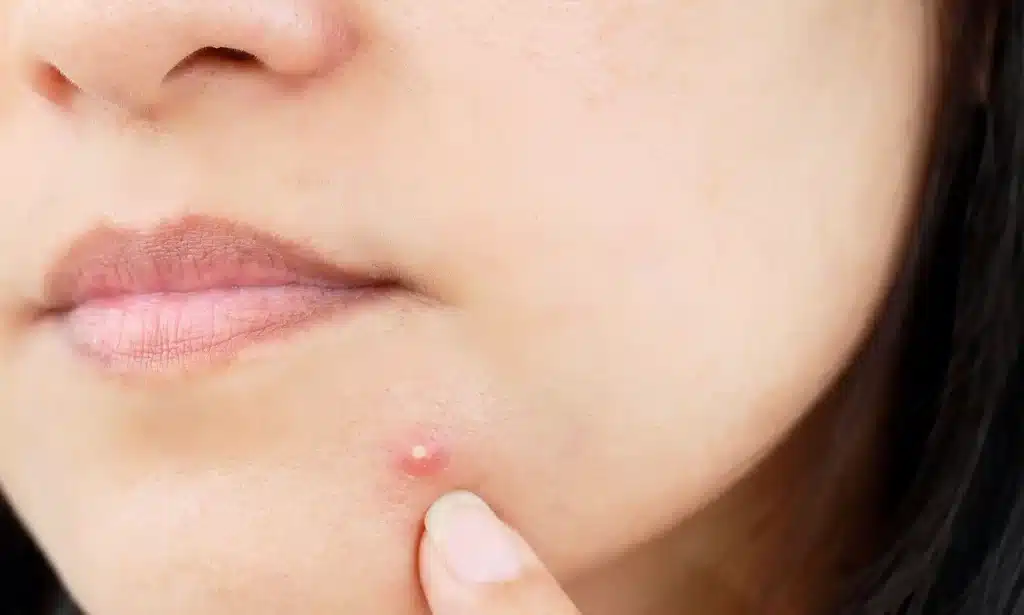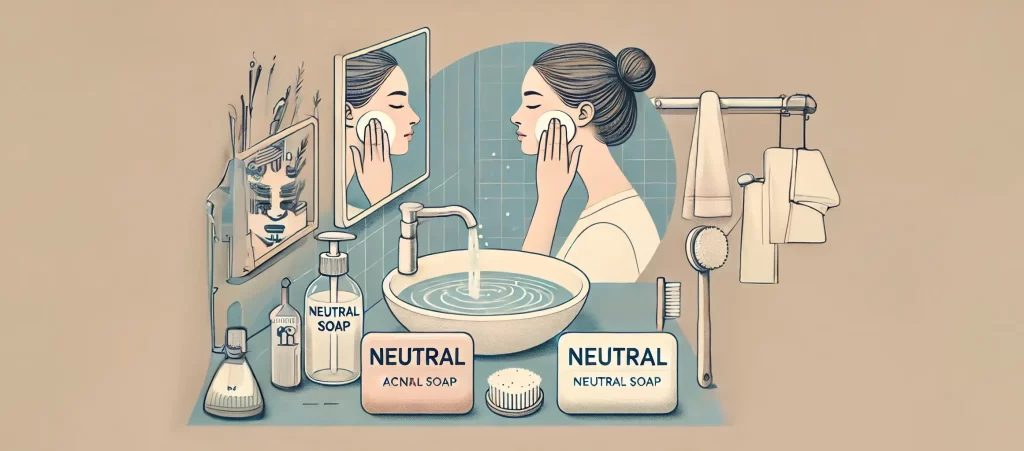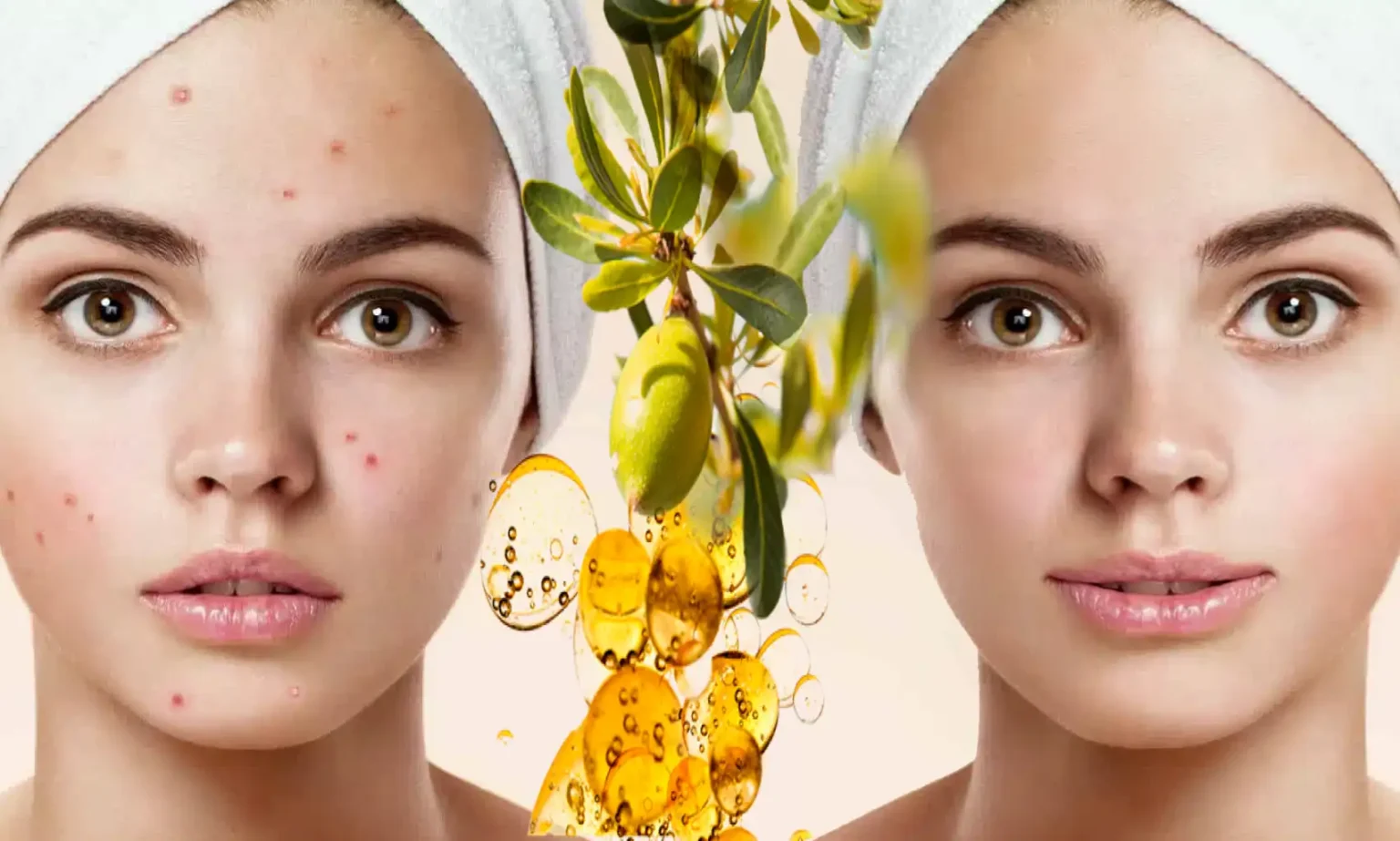Acne, one of the most common skin conditions, affects millions worldwide, manifesting as pimples, blackheads, and inflamed patches of skin. Triggered by factors such as hormonal changes, stress, diet, and improper skincare, acne can be a persistent challenge. However, understanding these triggers and how to combat them with a targeted skin care routine can make a significant difference in skin health.
The key to managing acne effectively lies in simplicity and consistency. In this blog post, we introduce a straightforward two-step routine designed to tackle acne from the comfort of your home. The morning starts with a gentle wash using a neutral soap to cleanse the skin of overnight oils and impurities without causing irritation. At night, the focus shifts to nourishment and repair with the application of argan oil, a potent natural remedy known for its anti-inflammatory and healing properties.
This simple routine, comprising just two products, promises to not only manage acne but also enhance the overall health and appearance of your skin. By addressing acne with the right products at the right times, you can maintain a clear complexion and prevent future breakouts.
Now, let’s explore how each component of this routine works to fight acne and why they are chosen for their specific benefits. Stay tuned as we break down the process and provide you with all the tips you need to get the most out of your skin care regimen.
Understanding Acne: Causes and Types
Acne is a common skin condition that affects millions of people worldwide, from teenagers to adults. It occurs when the pores of your skin become blocked by oil, dead skin, or bacteria. Understanding the underlying causes and the various types of acne can help in developing an effective skin care routine tailored to your specific needs.

What Causes Acne?
The development of acne is primarily influenced by:
- Excess Oil Production: Overactive sebaceous glands produce excess sebum, which can clog pores.
- Clogged Pores: Dead skin cells, dirt, and other impurities can accumulate and plug the pores.
- Bacteria: The presence of Propionibacterium acnes bacteria in the pores can lead to inflammation and worsening of acne.
- Inflammation: When the immune system reacts to bacteria or other irritants within the pore, it can cause the surrounding skin to become red, swollen, and painful.
Types of Acne
Understanding the different types of acne is crucial for effective treatment:
- Blackheads (Open Comedones): These appear as small black or dark-colored spots on the skin; they are clogged pores that remain open at the surface.
- Whiteheads (Closed Comedones): These are clogged pores that are closed by the skin on top, appearing as small, white or flesh-colored bumps.
- Papules: Small, red, raised bumps caused by infected or inflamed hair follicles.
- Pustules: Similar to papules, but filled with pus due to bacterial infection.
- Cysts: Deep, painful, pus-filled pimples that can cause scars.
- Nodules: Solid, often painful lumps beneath the surface of the skin.
Importance of Tailored Skin Care
Each type of acne might require a different approach. For instance, mild comedonal acne might benefit from topical treatments such as retinoids, while more severe inflammatory acne may require systemic treatments like antibiotics or isotretinoin. A tailored skin care routine is essential to address the specific type and severity of acne you are experiencing. This includes choosing the right cleansers, moisturizers, and spot treatments that won’t exacerbate your skin issues.
Moreover, understanding the root causes and types of acne can help in preventing new breakouts by adopting habits that reduce oil production, enhance skin cell turnover, and minimize inflammation.
Adopting a skin care routine that considers these factors can significantly improve your skin health, reducing the occurrence and severity of acne.
Morning Routine: Washing with Neutral Soap
Starting your day with the right skin care routine can significantly impact the health and appearance of your skin, especially if you are prone to acne. Using a neutral soap in the morning is a gentle yet effective way to manage acne. Here’s why and how you should incorporate this into your daily regimen.

Benefits of Using Neutral Soap for Acne-Prone Skin
Gentleness: Neutral soap, also known as pH-balanced soap, is formulated to match the natural pH level of the skin, which is typically around 5.5. This mildness helps prevent the skin from becoming too dry or too oily, conditions that can exacerbate acne.
Non-Irritating: Unlike typical soaps that may contain harsh chemicals or fragrances, neutral soap is free from these irritants, making it suitable for sensitive and acne-prone skin types.
Effective Cleansing: It effectively removes dirt, excess oil, and impurities from the skin without stripping away essential moisture, thus preventing the clogging of pores that can lead to acne breakouts.
Step-by-Step Guide on Properly Washing Your Face with Neutral Soap
- Wet Your Face with Lukewarm Water: Start by splashing your face with lukewarm water. Hot water can irritate the skin, while cold water won’t effectively dissolve the oil and dirt.
- Apply the Soap Gently: Rub the neutral soap between your hands to create a lather. Then, apply it to your face using your fingertips. Gently massage the soap into your skin in circular motions, focusing on areas that are particularly oily or acne-prone.
- Rinse Thoroughly: After massaging for about a minute, rinse your face thoroughly with lukewarm water. Ensure all soap residue, which could irritate the skin and clog pores, is completely washed off.
- Pat Dry: Use a clean towel to gently pat your face dry. Avoid rubbing the skin with the towel as this can cause irritation.
- Follow Up with Moisturizer: After washing your face, apply a light moisturizer that is non-comedogenic (won’t clog pores). This helps maintain the skin’s natural protective barrier and hydration level.
Incorporating neutral soap into your morning routine is a simple yet effective step towards clearer, healthier skin. By cleansing gently and effectively, you set a foundation for a skin care regimen that combats acne without causing irritation or dryness.
Evening Routine: Applying Argan Oil
Ending your day with a nourishing treatment can significantly enhance your skin’s health, especially if you are dealing with acne. Argan oil, known for its healing and restorative properties, is an excellent choice for an evening skin care routine. Here’s why argan oil is beneficial and how you can apply it effectively to get the best results.

Properties of Argan Oil for Acne-Prone Skin
Rich in Antioxidants and Vitamin E: Argan oil is packed with antioxidants and vitamin E, which help protect the skin from free radical damage while nourishing and revitalizing skin cells. This aids in reducing inflammation and promoting healing, which is crucial for acne-prone skin.
Natural Moisturizer: Unlike heavier oils that might clog pores, argan oil offers lightweight moisture that doesn’t contribute to acne. Its non-greasy texture helps regulate sebum production, maintaining the skin’s oil balance.
Antibacterial Properties: The antibacterial and fungicidal properties of argan oil help keep acne-causing bacteria at bay, reducing breakouts and skin infections.
How to Apply Argan Oil Effectively
Step 1: Cleanse Your Skin: Before applying argan oil, ensure your face is thoroughly cleansed with a gentle cleanser to remove any impurities or residues from the day.
Step 2: Apply a Few Drops: Argan oil is potent, so a little goes a long way. Dispense 2-3 drops of argan oil onto your palm.
Step 3: Warm the Oil: Rub your palms together gently to warm up the oil, which helps it penetrate the skin more effectively.
Step 4: Gently Apply to Your Face: Using your fingertips, apply the oil in a gentle patting motion, focusing on areas that are dry or prone to acne. Avoid rubbing vigorously as this can irritate the skin.
Step 5: Allow to Absorb: Give the oil a few minutes to absorb into the skin before heading to bed. Argan oil should absorb nicely without leaving a greasy residue.
Incorporating argan oil into your evening routine not only helps in combating acne but also contributes to a healthier, more radiant complexion over time. With regular use, you’ll notice a decrease in breakouts and a smoother, clearer skin texture.
The Science Behind Argan Oil and Acne
Argan oil, often referred to as ‘liquid gold,’ is celebrated not just for its aesthetic and culinary virtues but also for its considerable benefits in skin care, particularly for acne-prone skin. This section delves into the scientific aspects of argan oil that make it effective against acne, supported by research highlighting its therapeutic properties.

Key Components of Argan Oil Beneficial for Acne-Prone Skin
Antioxidants: Argan oil is rich in antioxidants like vitamin E and ferulic acid, which protect the skin from oxidative damage caused by free radicals. These antioxidants also enhance skin cell regeneration and improve skin elasticity, which can help reduce the appearance of acne scars.
Essential Fatty Acids: It contains an abundance of linoleic acid, an omega-6 fatty acid that can help reduce inflammation and soothe acne-related irritation. Linoleic acid also helps to moisturize the skin without clogging pores, balancing sebum production and reducing the occurrence of breakouts.
Anti-inflammatory Properties: The triterpenoids naturally occurring in argan oil offer skin protection, apart from their noticeable anti-inflammatory effects. They help to calm inflamed, acne-prone skin and can assist in healing minor skin abrasions, reducing acne scars’ visibility over time.
Antibacterial Agents: Argan oil has been found to possess antibacterial properties that help combat acne-causing bacteria on the skin’s surface. This reduces bacterial inflammation that can lead to acne outbreaks.
Research Supporting Argan Oil’s Effectiveness
Several studies underscore the beneficial impact of argan oil on the skin:
- Clinical Research: Research studies have shown that the topical application of argan oil leads to a significant increase in skin elasticity, which can help prevent and reduce acne scars.
- Case Studies: There are numerous documented instances where regular use of argan oil has visibly reduced active acne lesions and helped to heal acne scars, promoting a clearer and healthier complexion.
Using argan oil as part of your daily skin care routine can thus not only help manage active acne but also improve the overall health of your skin, making it a valuable addition to acne treatment regimens.
Additional Home Remedies for Acne
In addition to your daily skin care routine, incorporating natural supplements and homemade acne treatments can further enhance your skin’s health and combat acne effectively. Here are some natural ingredients and recipes you can try at home to support your skin health and treat acne.

Natural Supplements and Ingredients
1. Aloe Vera: Aloe vera is renowned for its soothing and anti-inflammatory properties. It helps reduce acne redness and swelling and accelerates the healing process.
2. Tea Tree Oil: Known for its antibacterial properties, tea tree oil can combat acne-causing bacteria, making it a potent addition to your acne treatment arsenal. Always dilute it with a carrier oil to prevent skin irritation.
3. Zinc Supplements: Zinc helps reduce inflammation and is critical for skin healing and bacteria regulation. Taking zinc supplements can help reduce acne outbreaks.
4. Green Tea: High in antioxidants, green tea can be consumed or applied topically to reduce inflammation and decrease sebum production, which are key contributors to acne.
Recipes for Homemade Acne Treatments
Honey and Cinnamon Mask:
- Ingredients:
- 2 tablespoons of honey
- 1 teaspoon of cinnamon
- Directions:
- Mix the honey and cinnamon to form a paste.
- Apply the mask to your face or affected area and leave it on for 10-15 minutes.
- Rinse off with warm water and pat dry.
Green Tea Toner:
- Ingredients:
- 1 cup of brewed green tea (cooled)
- 1 teaspoon of lemon juice
- Directions:
- Combine the green tea and lemon juice in a bottle.
- After cleansing your face, apply the toner with a cotton ball.
- Do not rinse, let it air dry for added benefits.
These natural remedies can be a valuable part of your skin care regimen, offering gentle yet effective treatment options for managing acne. Incorporating these into your routine can help you achieve clearer, healthier skin.
Diet and Acne: What to Eat and Avoid
The link between diet and skin health, particularly in relation to acne, is a subject of growing interest and research within dermatology. Certain foods can exacerbate acne, while others might help prevent or reduce its severity. Understanding what to include and avoid in your diet can be a powerful tool in managing acne.
Foods to Include for Better Skin Health
1. High in Omega-3 Fatty Acids: Foods rich in omega-3 fatty acids, such as salmon, flaxseeds, and walnuts, help reduce inflammation, which is a key factor in acne outbreaks.
2. Rich in Antioxidants: Brightly colored fruits and vegetables like berries, carrots, and spinach are high in antioxidants. These help combat free radicals in the body, reducing inflammation and improving skin health.
3. Zinc-Rich Foods: Zinc plays a crucial role in healing the skin and regulating hormone levels. Foods high in zinc, such as pumpkin seeds, lentils, and beef, are beneficial for acne-prone skin.
4. Complex Carbohydrates: Whole grains, legumes, and whole fruits have a low glycemic index. They help maintain stable blood sugar levels, which is important because spikes in blood sugar can trigger acne.
Foods to Avoid
1. Dairy Products: Some studies suggest that cow’s milk may promote acne due to hormones present in milk; however, the evidence is mixed. Consider moderating intake to see if your skin’s condition improves.
2. High Glycemic Index Foods: Foods that cause a rapid rise in blood sugar, such as sugary snacks, white bread, and potatoes, can exacerbate acne. These lead to an overproduction of oil, contributing to clogged pores.
3. Greasy Fast Food: High-fat diets can increase sebum production, which exacerbates acne. Avoiding greasy, fried foods can help reduce the occurrence of oily skin and acne.
4. Chocolate: While chocolate lovers might find this disappointing, some research indicates that chocolate can increase the severity of acne. Observing how your skin reacts to chocolate might help you determine if it’s a trigger for you.
Incorporating dietary changes as part of your acne management strategy can lead to visible improvements in your skin. While these dietary tips may help, it’s also important to maintain a balanced diet and consult with a healthcare provider or nutritionist to address specific health needs or concerns.
Lifestyle Changes to Support Acne Reduction
Managing acne effectively goes beyond just topical treatments and dietary adjustments; incorporating certain lifestyle changes can have a significant impact on your skin’s health. Here’s how sleep, stress management, and exercise play crucial roles in combating acne:
Importance of Sleep
Sleep is vital for overall health and particularly important for skin health. During sleep, your body repairs itself, which includes rejuvenating your skin.
- Promotes Skin Repair: The growth hormone released during sleep helps repair and regenerate skin cells. Lack of sleep can disrupt this process, leading to increased inflammation and worsened acne conditions.
- Reduces Stress: A good night’s sleep can lower stress levels, which in turn can reduce the severity of acne. High stress levels are associated with increased acne breakouts due to the production of stress hormones like cortisol.
Stress Management
Managing stress is crucial in the fight against acne because stress triggers the body to produce more of the hormones that can worsen acne.
- Mindfulness and Relaxation Techniques: Practices like yoga, meditation, and deep-breathing exercises can significantly reduce stress levels.
- Regular Relaxing Activities: Engaging in hobbies or activities that you find relaxing can help manage stress effectively, reflecting positively on your skin health.
Exercise
Regular physical activity can improve your acne by:
- Increasing Blood Circulation: Exercise enhances blood flow, which helps nourish skin cells and keep them healthy. Improved circulation also helps carry away waste products, including free radicals, from working cells.
- Regulating Hormones: Exercise can help balance the body’s hormones through the reduction of insulin levels and increasing insulin sensitivity, which can in turn reduce the severity of acne.
Implementing Changes
- Set Realistic Goals: Start with manageable changes like going to bed at the same time each night, incorporating short meditation sessions into your daily routine, and scheduling regular exercise.
- Consistency is Key: The benefits of these lifestyle changes accrue over time. Consistent practice is essential for seeing results.
By understanding and incorporating these lifestyle adjustments, you can create a supportive environment not just for your skin but for your overall health. Combating acne effectively requires a holistic approach, and these changes can form a fundamental part of your strategy.
Common Mistakes in Acne Care
When managing acne, it’s easy to fall into practices that seem beneficial but can actually exacerbate the condition. Understanding what to avoid is as crucial as knowing what to do. Here are some common mistakes in acne care and why they can be detrimental to your skin health.
Overwashing the Face
Mistake: Washing your face more than twice a day or using harsh cleansers. Why It’s a Problem: Overwashing can strip your skin of its natural oils, leading the skin to produce more oil to compensate. This can increase the likelihood of acne breakouts.
Using Harsh Scrubs
Mistake: Using abrasive scrubs to exfoliate acne-prone skin. Why It’s a Problem: Harsh physical exfoliants can irritate the skin and aggravate acne. It’s better to use gentle exfoliating agents that do not damage the skin’s surface.
Popping Pimples
Mistake: Squeezing or popping pimples. Why It’s a Problem: Popping pimples can push bacteria and pus deeper into the skin, causing more inflammation and even scarring.
Using Alcohol-Based Products
Mistake: Applying products that contain high concentrations of alcohol. Why It’s a Problem: Alcohol can overly dry out the skin, which may trigger increased oil production and worsen acne.
Neglecting Moisturizer
Mistake: Skipping moisturizer, especially if you have oily skin. Why It’s a Problem: Moisturizers help maintain the skin’s barrier function and prevent it from producing excess oil due to dryness.
Ignoring Ingredients
Mistake: Not checking the ingredients of skincare products. Why It’s a Problem: Some ingredients can clog pores or cause allergic reactions, which can exacerbate acne. Look for non-comedogenic products that are specifically formulated not to block pores.
By avoiding these common mistakes, you can ensure your skin care routine is supportive rather than detrimental to your acne management efforts. It’s important to approach acne care with a gentle and balanced routine, focusing on products and methods that soothe and heal the skin.
Conclusion: Reinforcing Your Acne Care Routine
As we’ve explored, managing acne effectively involves more than just occasional treatments; it requires a dedicated routine that nurtures and protects your skin both morning and night. By starting your day with a gentle cleanse using a neutral soap and ending with the nourishing touch of argan oil, you establish a powerful regimen that combats acne and promotes overall skin health.
The Power of Consistency
The true effectiveness of this skin care routine lies in its consistent application. Regular use of neutral soap in the morning helps to maintain a clean and balanced skin surface, preventing the buildup of oils and impurities that can lead to breakouts. At night, argan oil works its magic by deeply moisturizing, healing, and reducing inflammation, aiding in the repair of the skin while you sleep.
Encouragement to Persist
If you are struggling with acne, remember that improvements in skin condition take time and persistence. The morning and evening routines described here are designed to support the skin’s natural processes, offering gradual improvements that accumulate over time. As you continue with these practices, you are likely to see a reduction in breakouts and an enhancement in the overall texture and appearance of your skin.
We encourage you to stick with these routines, adjusting as necessary to fit your skin’s responses and needs. With each day, you are taking steps toward clearer, healthier skin.
Final Thoughts
As you turn these routines into habits, you’ll find that managing acne becomes a more integrated and less daunting part of your day. Keep informed about new insights and products that can enhance your routine, always focusing on what best suits your skin type and condition.
Ressources
National Institute of Arthritis and Musculoskeletal and Skin Diseases – Acne Information
- Access detailed information about acne causes, treatments, and tips for managing the condition.
- Visit NIAMS Acne Information
PubMed Health – Research on Acne Treatments
- Review scientific studies and clinical trial results on various acne treatments.
- Search Acne Treatments on PubMed
The Mayo Clinic – Acne Treatments and Drugs
- Get insights into the different medical treatments for acne, including descriptions of procedures and medications.
- Visit Mayo Clinic Acne Treatments


0 thoughts on “Transform Your Skin: The Ultimate Morning-to-Night Acne Fighting Guide”